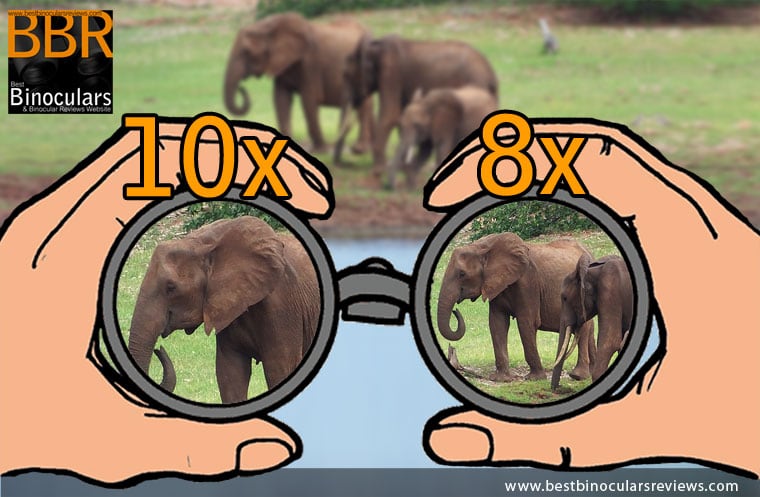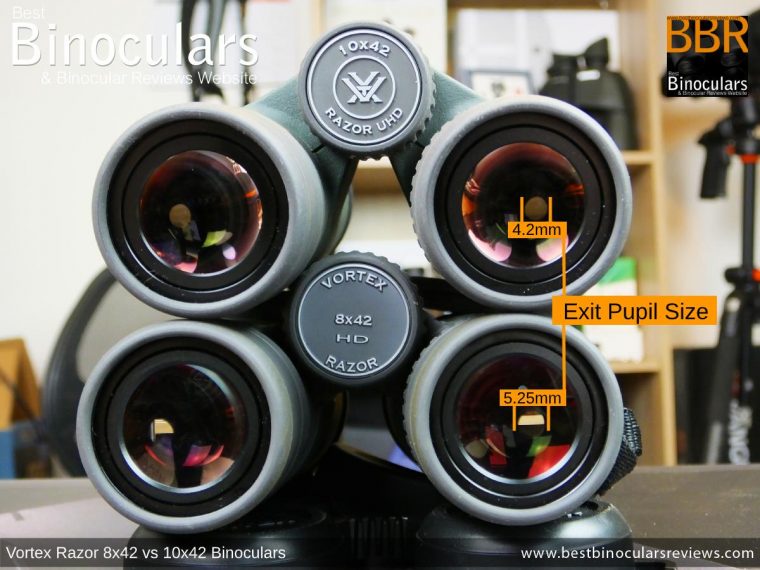8x42 vs 10x42 Binoculars
Image quality, detail, brightness, low light performance, field of view and price. In this article I go over the main differences that you can expect between typical 8x42 vs 10x42 binoculars of similar quality and thus no matter if your interest is general use, birding, wildlife observation or hunting, it will help you to decide which configuration is best for your particular needs and preferences.
I recently completed an article where I discussed the main differences between 10x42 vs 10x50 binoculars which I got a lot of positive feedback from. However, I have also had a lot of people asking me to compare other configurations against each other and so I have decided to create a series on this, beginning with the one I get asked the most to compare: 8x42 vs 10x42 binoculars and which is best for different uses and users.
Below I go over in-depth, the differences in the physical characteristics as well as the all-important optical performance differences that you will get between similar quality 8x42 and 10x42 binoculars.
Understanding these core distinctions will enable you to then understand which option is more ideal for what or how you specifically use your binoculars.
By the way, if you are in doubt, be sure to first check out What the Numbers Mean on a Binocular.
Physical Differences
Unlike binoculars that have different sized objective lenses (eg 10x42 vs 10x50), the disparity in the size and weight between an 8x42mm and 10x42mm binocular is extremely minimal and really not worth worrying about.
Indeed most brands will list their 8x42 and 10x42 models within the same series as having identical size and weights.
Size-wise they will be the same as they will almost certainly use the same body, however, a 10x42 is often a fraction heavier than an 8x42 as they need slightly thicker glass to create the higher power. But as I say the amount is really not worth considering as a factor in making your choice between the two.
Optical Differences
8x or 10x Magnification
The whole purpose of using a binocular that magnifies the image is to provide you with a better view of distant objects. So it stands to reason that most people will assume that the more powerful a binocular is, the better.
However, whilst higher magnifications may potentially bring you a more detailed image at longer distances, there are also a number of drawbacks to this and thus inevitably there is a balance that needs to be struck and which one is best for you and your needs will depend on a number of factors:
Image Detail at Distance
There is no doubt that you will be able to observe more image detail or to put it another way “see more” at longer distances with a 10x42 binocular when compared to an equal quality 8x42 binocular.
Image Shake
But just keep in mind that any movement that you make gets multiplied by the magnification and thus you also get more image shake with a 10x42 vs 8x42 when hand holding them and thus even though the image may have more detail if it is shaking about too much you won’t be able to appreciate it.
For the majority of users with relatively steady hands, a 10x binocular is fine for hand-holding and it is only once you go above 12x to 15x that it becomes a problem. However, if you have particularly unsteady/shaky hands, this may be something worth keeping in mind and her an 8x instrument would make a better choice.

Seeing the Big Picture: Field of View
Thus if you get more image detail or are able to see further with a 10x binocular, you may be then be thinking why would you the ever opt for a lower-powered 8x binocular instead?
Well, one of the main problems with a more “zoomed in” image on a higher power is that it reduces your field of view.
At long distances, this is usually not as much of a factor, but at closer ranges, it can often mean that you don’t see the whole picture and thus can miss some important details.
So if we use a sporting event like baseball, cricket or football as an example. A 10x binocular may provide you with a better view of the batsman or person on the ball, but you won’t be able to observe what is going on all around them and thus in many cases, an 8x binocular with a wider view will be a better option as the best binocular for sports.
Likewise, for birding and wildlife observation at close to mid-distances, a lower 8x power with a wider view makes it much easier to quickly locate and then follow your subject. In a forest setting where your subject is difficult to spot, this can be a really important factor.
Light Gathering
As both 10x42 and 8x42 binoculars have 42mm objective lenses and assuming they use the same quality glass and coatings, the light-gathering ability between the two will be the same.
Image Brightness & Low Light Performance
However, even though both 8x and 10x 42mm binoculars are able to capture the same amount of light, they will have different capabilities in terms of the image brightness:

Exit Pupil Size
This difference between the two can largely be explained by the relationship between the size of the pupils in your eyes and the size of the shafts of light exiting the ocular lenses (exit pupil) of the binocular:
- 8x42 binoculars create a 5.25mm exit pupil (42/8)
- 10x42 binoculars create a 4.2mm exit pupil (42/10)
In good to average light conditions, most people’s pupils will constrict to a size smaller or at least equal to 4mm and thus both an 8x42 and a 10x42 binocular will be supplying your eyes with more than enough light for you to work with and thus perceive a bright image.
Thus under these conditions, it is often impossible to notice a difference in brightness between the views of equal quality 8x42 and 10x42 binoculars.
However, when the ambient light level drops, like when operating in a forest, or what you experience just before sunrise or around sunset, the pupils in your eyes expand to allow them to take in more light.
Here the larger exit pupil created by the 8x42 configuration is a definite advantage and means they will often look to have a brighter image than the 10x42 equivalent. Therefore even though they both collect the same amount of light and the 10x power potentially gives you more image detail, you cannot actually see it.
More info on all of this can be found in my complete guide to the Exit Pupil.
Transmittance & Glass Thickness
Higher magnifications require thicker lenses, which in turn means less light passes through them.
Whilst this difference in transmittance between equal quality 10x42 vs 8x42 binoculars is minimal it only really becomes a factor under more extreme low light situations.
Ease of Use
A larger exit pupil/shaft of light exiting the binocular is also easier for you to line your eyes up with and thus the 8x42 configuration is more forgiving making it easier to achieve an image without black rings on the edges of the view.
Price Difference
Whilst not always the case and it varies between brands, 10x42 binoculars can be a little more expensive than the equivalent 8x42 model from the same brand in the same series.
So whilst it is true that they need a fraction more glass to make the thicker eyepiece lenses for the higher magnification, this is not really the reason for the price difference, so what is?
Economies of Scale
8x42 is the most popular binocular configuration and thus manufacturers often make/order more parts for these, which in turn brings the overall production costs of these down.
Conclusions
10x42 or 8x42, Which is the Best?
As I have said many times and is most certainly the case when choosing between 8x42 or 10x42 binoculars: There is no single best option, rather it boils down to selecting the right choice for your particular requirements:
With its wider view, an 8x42 binocular is best at shorter to mid-distances, especially if you need to follow small, fast or erratic moving objects like birds or other smaller mammals.
8x42’s will also look to have a brighter image in low light and thus will make a better choice if you often operate in woodlands, forests or when the sun is at or just below the horizon.
10x42 binoculars work best for normal to good light conditions over mid to long distances. Thus a 10x42 binocular will best suit those who mostly operate during the day in wide-open spaces, so for example in fields, out on the hills, along a lakefront or at the coast.
Further Reading & Related Info
- Compare all 8x42 and 10x42 binoculars reviewed on BBR
- 8x42 or 10x42 Binoculars: Which is Best for Novice / Older Child?
- What do Binocular Numbers Mean?
- How Different Configurations Affect a Binocular
- What To Look For When Buying Binoculars
- 10x42 vs 10x50 Binoculars
- 7x50 vs 8x56 Binoculars for Astronomy & Daytime Surveillance
- 15x56 vs 18x56 Binoculars

 Article | Posted by Best Binocular Reviews
Article | Posted by Best Binocular Reviews 
 Categories:
Categories:  Tags:
Tags: 


Thank you for this information!! I’m 70 years old & wanted to get back into birding, after a long lapse. I have a bit of an essential tremor, so your guide helped me choose the 8x42 lenses as best for my situation. Take care! 🙂
Hi there – many thanks for the feedback and I am really happy to hear that in some small way, I have been of help to you. All the best, Jason